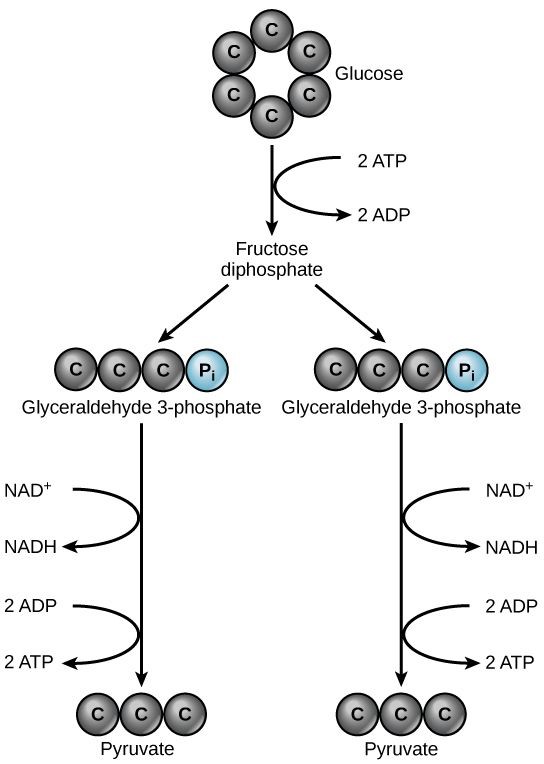Chapter 12: Cellular Respiration
12.2. Glycolysis
Learning Objectives
By the end of this section, you will be able to:
- Describe the overall result in terms of molecules produced during the chemical breakdown of glucose by glycolysis.
- Compare the output of glycolysis in terms of ATP molecules and NADH molecules produced.
The energy of glucose resides in its chemical bonds. Glycolysis is the first step in the breakdown of glucose to extract energy for cellular metabolism. Nearly all living organisms carry out glycolysis as part of their metabolism. The process does not use oxygen and is therefore anaerobic.
Glycolysis takes place in the cell cytoplasm. Blood glucose enters cells by facilitated diffusion with help of carrier proteins called GLUT transporters.
Simplified overview of glycolysis
Glycolysis begins with one 6-carbon glucose molecule and ends with two 3-carbon sugars, called pyruvate. In addition, two ATP molecules are produced and the coenzyme NAD+ is reduced to NADH. Reduced, high energy NADH molecules are produced to play their role as electrons (and H+) carriers (Figure 12.2.1.).

Details of Glycolysis
Glycolysis is a ten-step metabolic pathway
- The first five steps (1-5) are the ATP-investment phases: ATP is used to convert glucose to a three-carbon intermediate sugar, glyceraldehyde phosphate (Figure 12.2.2.).
- The next five steps (6-10) are production phases; enzyme-catalyzed reactions and atom rearrangements result in the final products – ATP, reduced coenzyme NADH and pyruvate (Figure 12.2.3.).


Glycolysis is an anaerobic process: the reactions can occur independent of the present of oxygen. If Oxygen levels in the cells are LOW, pyruvate chemical reactions will result in the formation of lactic acid. While in the presence of sufficient oxygen, pyruvate continues to Phase 2 (Citric acid cycle).
Mitochondrion structure
The next two phases take place in different locations of the mitochondrion. Take a moment to review its structure, paying close attention to the matrix, inner membrane, and intermembrane space. You can refer back to the diagram as you read the next sections (Figure 12.2.4.).

License and attributions:
- Biology, Second edition, 2018, Clark, M.A. et al. License: CC BY 4.0. Located at https://openstax.org/books/biology-2e/pages/7-2-glycolysis
- Concepts of Biology, 2013, Fowler, S. et al. License: CC BY 4.0. Located at https://openstax.org/books/concepts-biology/pages/4-2-glycolysis
